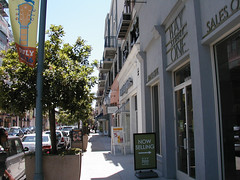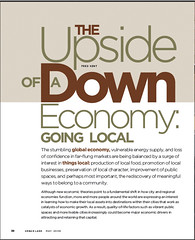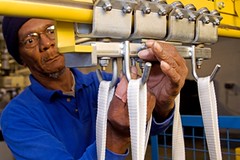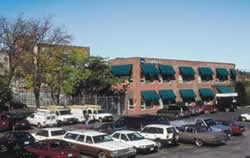Thinking about the economics of sustainable communities

Posted June 14, 2010 at 1:28PM
Last week, I spoke to the annual convention of the American Institute of Architects in Miami Beach, as part of a session on neighborhood density. We had a sizable, knowledgeable and attentive audience, and I was struck by the fact that most of the comments and questions after our session were about what we need to do to craft sustainable urban economies, not the facts and figures we had presented regarding the market for walkable neighborhoods, how to design for environmental sustainability, and the dividends that urban densities can bring to their communities.
Moving beyond physical form
My friends David Dixon, Laurie Volk and I have been evolving conference sessions on density for several years now, and this was the fourth or fifth time we have presented together at some forum or other.  After the session, we were all struck by how much of what we have been saying about neighborhood form has now become mainstream and, in a sense, carries less urgency at this point because the market is already headed in the directions we advocate (which, by the way, is exactly what Laurie has been saying).
After the session, we were all struck by how much of what we have been saying about neighborhood form has now become mainstream and, in a sense, carries less urgency at this point because the market is already headed in the directions we advocate (which, by the way, is exactly what Laurie has been saying).
As a result, we want to evolve our package of ideas further to respond to the new edges that interest our audience. Our expertise is in the built environment, so we must remain grounded there, but I think we may need to broaden our concept of sustainability well beyond the tenets of smart growth and urbanism that we have been advocating and look more closely at the social aspects of sustainable communities, particularly inclusion and jobs.
Readers who have been following this blog for a while know that, for some time, I have been musing that ‘smart growth,’ as we have known it – directing development to the right places and away from the wrong ones – is no longer enough. Neither is urbanism, or shaping development into the right forms – whether it be ‘new,’ old or, as I think of some unfortunate attempts to insert traditional street grids and neighborhood clusters into exurban prime farmland, ‘neo’ urbanism. And those of us who think of places in addition to buildings have known for a long time that green building isn’t enough.
Instead, as some commenters were saying on one of my posts earlier this month, we need all three of these elements working together. But that combination, although essential, still only gets us so far. As a mayor in our AIA audience reminded us, the physical form won’t work unless there is a stronger underlying economy to support it. And that economy may need to take new forms.
The Cleveland model
This brings me to something I have been meaning to write about, thanks to a link sent by NRDC trustee Patricia Bauman some time back: community-oriented, cooperative businesses being pioneered in Cleveland. Gar Alperovitz, Thad Williamson and Ted Howard write in The Nation:
“Something important is happening in Cleveland: a new model of large-scale worker- and community-benefiting enterprises is beginning to build serious momentum in one of the cities most dramatically impacted by the nation's decaying economy. The Evergreen Cooperative Laundry (ECL)--a worker-owned, industrial-size, thoroughly ‘green’ operation--opened its doors late last fall in Glenville, a neighborhood with a median income hovering around $18,000. It's the first of ten major enterprises in the works in Cleveland, where the poverty rate is more than 30 percent and the population has declined from 900,000 to less than 450,000 since 1950.”
Evergreen will focus on serving the health care industry, which has a substantial presence in Cleveland and a continuing need for large-scale laundry services. The company’s employees may buy shares of ownership in the venture through small payroll deductions over time. The business has taken care to make its operations as environmentally responsible as possible, using, for example, less than a third of the water that other industrial-sized operations use per pound of laundry.
 As the authors point out, Evergreen’s business plan is based on the experience of the wildly successful Mondragon Cooperative Corporation in the Basque Country of Spain. That large-scale cooperative effort now employs nearly 100,000 workers in an integrated network of more than 200 high-tech, industrial, service, construction, financial and other largely cooperatively owned businesses.
As the authors point out, Evergreen’s business plan is based on the experience of the wildly successful Mondragon Cooperative Corporation in the Basque Country of Spain. That large-scale cooperative effort now employs nearly 100,000 workers in an integrated network of more than 200 high-tech, industrial, service, construction, financial and other largely cooperatively owned businesses.
In addition to the laundry, other Evergreen cooperative start-ups in Cleveland include Ohio Solar Cooperative, which retrofits buildings with weatherization and photovoltaic rooftop panels; Green City Growers, a greenhouse-based, urban hydroponic farming operation-to-be; and Neighborhood Voice, a community newspaper. Although forced to begin life in a recession, these enterprises have been seeded with substantial financial backing:
“Significant resources are being committed to this effort by the Cleveland Foundation and other local foundations, banks and the municipal government. The Evergreen Cooperative Development Fund, currently capitalized by $5 million in grants, expects to raise another $10-$12 million--which in turn will leverage up to an additional $40 million in investment funds. Indeed, this may well be a conservative estimate. The fund invested $750,000 in the Evergreen Cooperative Laundry, which was then used to access an additional $5 million in financing, a ratio of almost seven to one.
An important aspect of the plan is that each of the Evergreen co-operatives is obligated to pay 10 percent of its pre-tax profits back into the fund to help seed the development of new jobs through additional co-ops.”
Other cities are said to be interested in following Cleveland’s path. All of this and more are detailed in the article, which I recommend.
Still in Ohio, operating at a much more modest initial scale but nonetheless to the great benefit of a recovering neighborhood’s economy, are some additional types of programs that I discovered last year while researching my series on Cincinnati’s Over-the-Rhine. For example, Power Inspires Progress operates a pizzeria on OTR’s Vine Street, while providing training in job skills to neighborhood residents, and the 500-member OTR Chamber of Commerce, which provides a wide range of services to the neighborhood and its residents, sponsors a number of programs to help small businesses in OTR. In many cases the Chamber's assistance has gone to minority-owned enterprises. (Beyond job and business assistance, Smart Money Community Services provides basic banking services to needy families in Over-the-Rhine through a credit union along with a range of educational programs on financial issues, "empowering families to achieve their financial goals while enhancing the quality of life in our community.")
Resources on the economics of sustainable communities
Especially with ‘green jobs’ having become a bit of a meme over the last year, I’m sure there are many more emerging examples of sustainable, community-based enterprises across the country. (For a discussion of how the Evergreen businesses in Cleveland contribute to green jobs, see this article by Andrea Buffa on the website of the Apollo Alliance.)
 Researching them all is far beyond the scope of a single blog post. One related and helpful resource, though, has recently been assembled by the American Society of Landscape Architects: an extensive, annotated and linked bibliography on the economics of sustainability, now on the organization’s website. Many of the links are related to ecosystem and landscape economics, as one might expect from ASLA, but many also venture into the broader field and very helpfully connect the economy of ecology with the economy of community. From the introduction:
Researching them all is far beyond the scope of a single blog post. One related and helpful resource, though, has recently been assembled by the American Society of Landscape Architects: an extensive, annotated and linked bibliography on the economics of sustainability, now on the organization’s website. Many of the links are related to ecosystem and landscape economics, as one might expect from ASLA, but many also venture into the broader field and very helpfully connect the economy of ecology with the economy of community. From the introduction:
“Sustainability Toolkit: Economic Models focuses on economic sustainability, which involves the development of a healthy economy that supports and sustains people and the environment over the long-term. In a market-driven economy, cost is a deciding factor in determining whether a project moves forward. To be sustainable, projects must not only provide environmental and social benefits, but also offer economic value. Ecosystem service models can also be used to quantify the inherent economic value of services nature already provides for free.
“The toolkit is arranged from macro- to micro-scales, beginning with sustainable regional planning, and moving to sustainable cities & communities planning, sustainable neighborhood planning, and, then finally, site-specific tools related to sustainable landscapes and green buildings.”
If some of an emerging, community-based economy can also serve to support ecosystems and healthy living, and vice versa, so much the better.
Move your cursor over the images for credit information.

